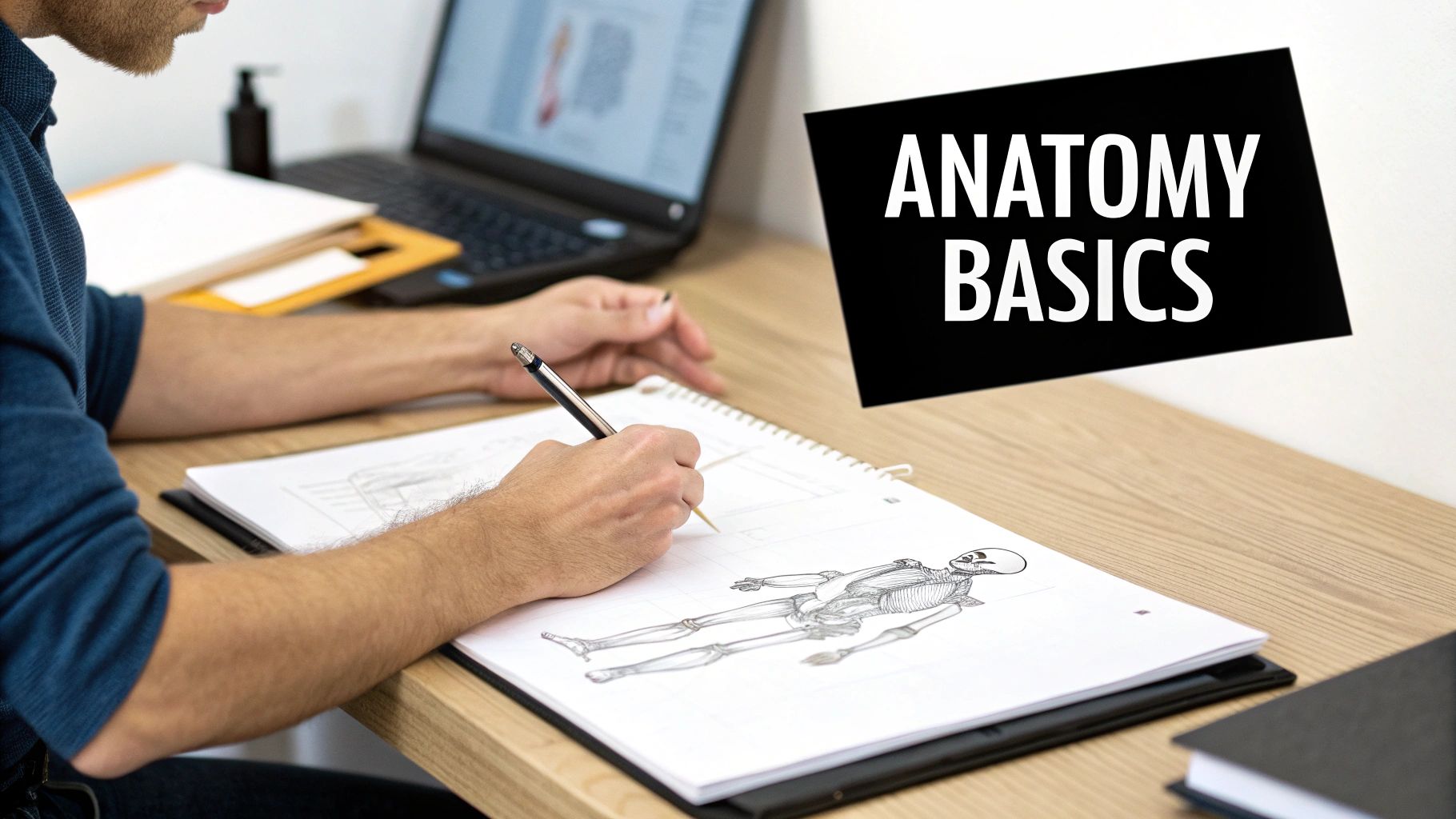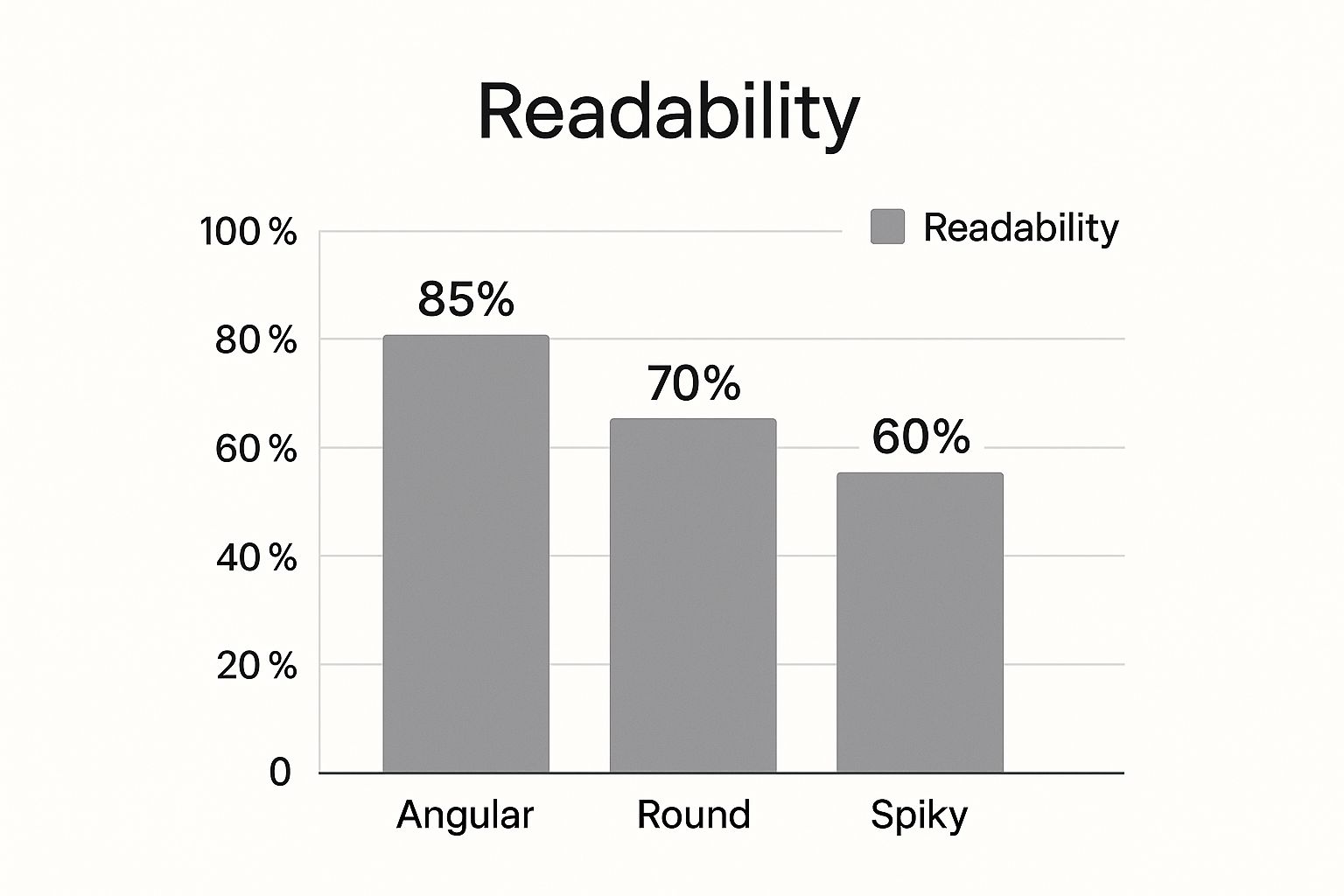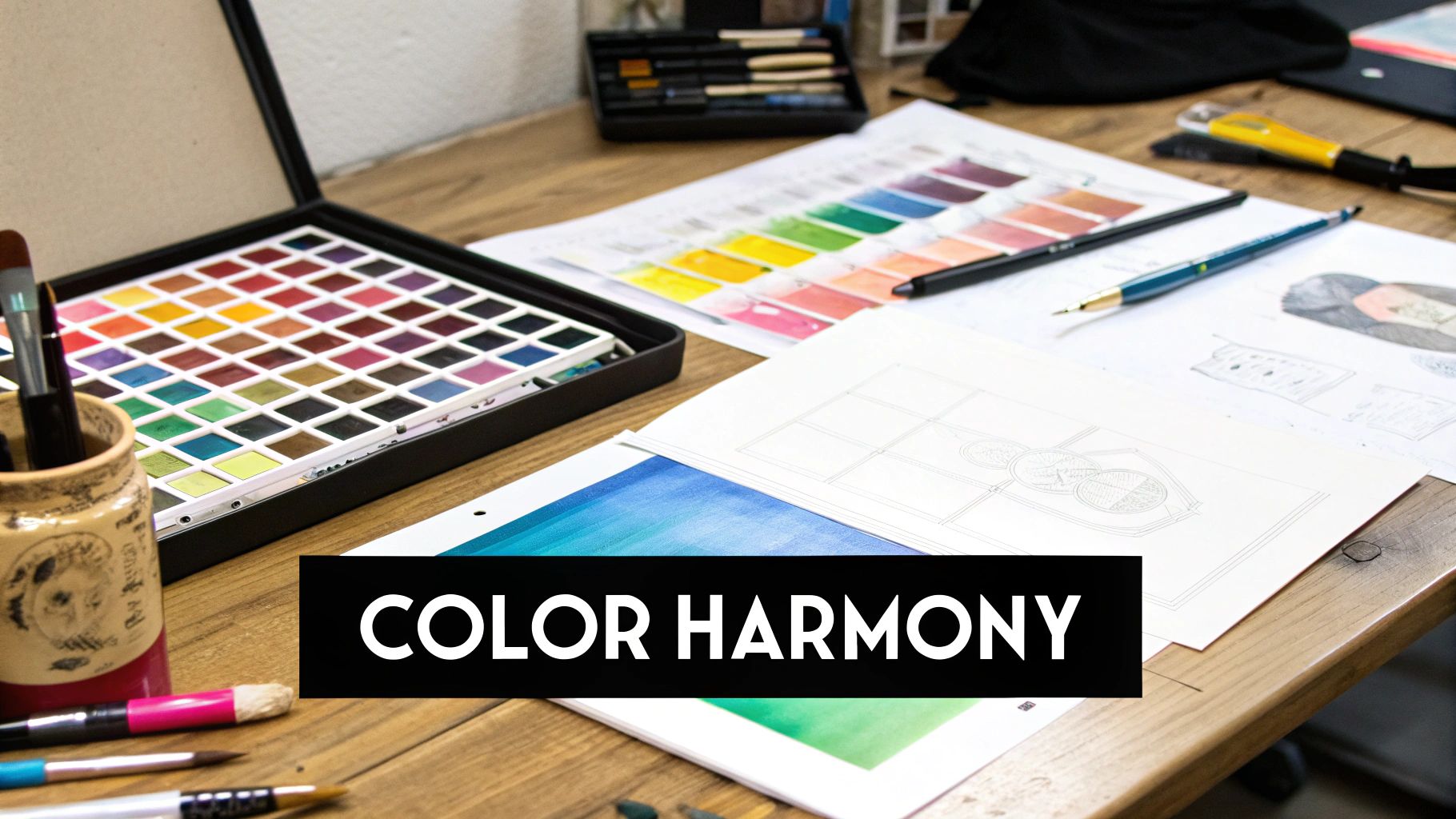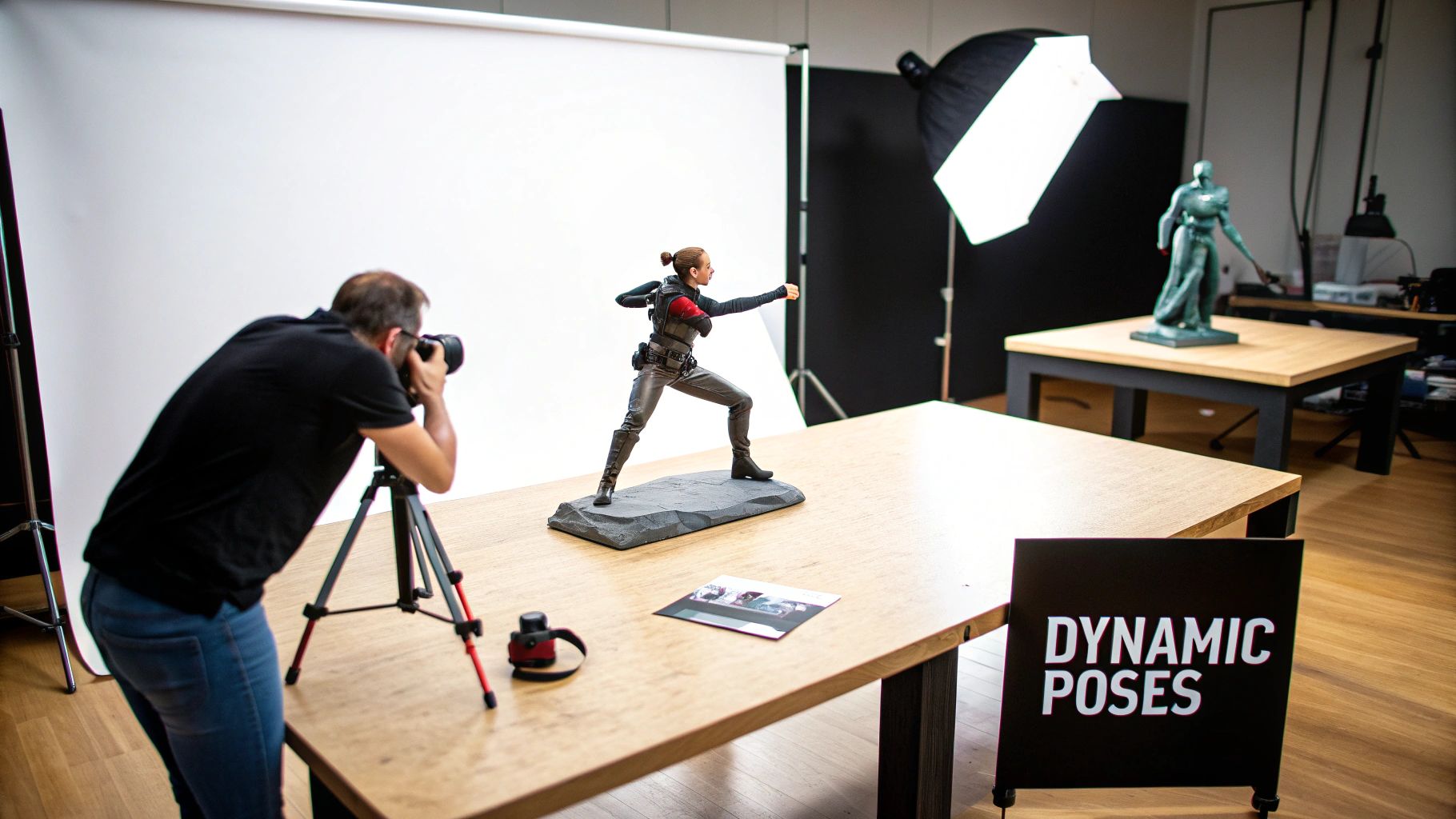Ever wonder why you can instantly recognize Mickey Mouse from just his ears or identify Darth Vader from his shadow alone? The answer is a masterful grasp of character design fundamentals. These aren't just rigid, academic rules; they're the core principles artists use to build memorable, believable characters that connect with an audience.
Think of them as the grammar of visual storytelling.
The Blueprint for Unforgettable Characters

The secret lies in the toolkit of principles like silhouette, shape language, color theory, and anatomy. Working together, they visually scream who a character is—their personality, their story, their role—long before a single word of dialogue is spoken.
At its heart, character design is about building a visual identity. Every choice is intentional, from the curve of a smile to the color of a coat. It’s all about forging that connection and making sure the character works within the story, whether it’s for a film, a video game, or a comic book. Great design makes a character feel alive. It ensures they’re not just seen, but felt and remembered.
Why Mastering the Fundamentals Matters
Without a solid handle on these concepts, even the most beautifully rendered drawing can fall completely flat. Sure, a character might look cool, but they won't feel cohesive or believable. The fundamentals provide the "why" behind your artistic decisions, giving your creations real depth and purpose.
A sign of good character design is a character being recognizable solely from their silhouette. It’s the ultimate test of clarity and iconic form, proving that the overall shape is more powerful than any intricate detail.
Understanding these principles is what separates simply drawing what looks good from designing with intention. It's the difference between a generic hero and a legendary one.
The Pillars of Character Design
This guide will walk you through the essential building blocks every artist needs in their corner. By digging into these concepts, you can start building a more strategic and effective creative process. These pillars are the foundation for all creative work, a concept you can explore further in these basic design principles that apply across any visual medium.
We’re going to focus on:
- Silhouette and Shape Language: How a character's outline and core shapes instantly telegraph their personality.
- Anatomy and Proportion: Building a believable structure that defines posture, movement, and presence.
- Color and Costume: Using palettes and clothing to reveal a character’s history, culture, and emotional state.
- Backstory and Personality: Tying the visual design back to a compelling narrative foundation.
The Power Of Silhouette And Shape Language
Ever seen a character's shadow on a wall and known exactly who it was? Think Mickey Mouse's ears or Batman's cowl. If you can name them from just the outline, you've just seen a powerful silhouette in action.
This is the absolute first impression your character makes. Before anyone sees the color of their eyes or the texture of their clothes, they register the overall shape. The "shadow test" is a classic for a reason—it’s a brutally honest way to see if your design is distinct or just another forgettable blob. A strong, readable silhouette makes sure your character pops, even from a distance or in the middle of a chaotic scene.
Decoding The Language Of Shapes
Beyond just being recognizable, shapes talk. This is shape language, and it's a kind of silent storytelling that every artist uses, whether they realize it or not. We're all hardwired to connect basic geometric forms with certain feelings and personality traits.
It’s how our brains take shortcuts to understand the world, creating a subconscious conversation between your design and the audience. Getting a handle on this language is what separates accidental design from intentional, powerful character creation. It's a huge part of how visuals speak to us, and you can dig deeper into these ideas by understanding the core principles of what is visual communication.
Shapes are the building blocks of personality. A circle feels different from a square, and a square feels different from a triangle. Mastering this language allows you to tell an audience who your character is without saying a word.
This infographic breaks down just how much readability is tied to the dominant shapes in a silhouette.

As you can see, sharp, distinct silhouettes are way easier to read at a glance. Softer, more ambiguous shapes can get lost in the noise.
The Three Primal Shapes And Their Meanings
Shape language really boils down to three primal forms: circles, squares, and triangles. Each one carries its own psychological punch and can be used to instantly telegraph a character's entire vibe.
-
Circles and Ovals: No sharp corners here. These shapes feel soft, safe, and friendly. They're perfect for characters you want the audience to see as approachable, innocent, or just plain lovable. Think cuddly sidekicks and gentle giants.
-
Squares and Rectangles: With their straight lines and hard angles, squares scream stability, strength, and reliability. They feel solid and dependable, but can also come off as rigid or stubborn. This is your go-to for stoic heroes, tough-as-nails authority figures, or anything that's meant to be an immovable object.
-
Triangles and Sharp Angles: Triangles are all about energy and direction. Pointing up, they can feel powerful or heroic. Pointing down, they often signal danger, aggression, and unpredictability. This is why so many villains, cunning tricksters, and speed-demons are built from sharp, triangular elements.
Here's a quick cheat sheet for how these fundamental shapes translate directly into character archetypes.
How Core Shapes Communicate Personality
| Shape | Associated Traits | Common Character Archetype Examples |
|---|---|---|
| Circle | Friendly, safe, innocent, approachable, harmless, soft | The cheerful sidekick, the innocent child, the gentle giant |
| Square | Stable, strong, reliable, grounded, dependable, rigid | The stoic hero, the tough authority figure, the dependable protector |
| Triangle | Dangerous, dynamic, aggressive, unpredictable, cunning | The classic villain, the fast-moving rogue, the cunning trickster |
Leaning on these core shapes gives you a massive head start in communicating your character's inner self before you've even drawn a single facial feature.
How To Build An Iconic Silhouette
Okay, theory's great, but how do you actually do it? Creating a knockout silhouette isn't about photorealism—it's about clarity and intentional choices.
- Start with Thumbnails: Forget the details for now. Start by sketching tons of tiny, rough outlines. Fill them in with solid black. This forces you to focus only on the overall shape and see what reads best.
- Exaggerate Key Features: What makes your character unique? Find one or two of those features and push them. Maybe it's ridiculously long arms, a wild hairstyle, massive horns, or a signature cape. Exaggeration creates distinction.
- Vary Proportions: Unless your character is meant to be Joe Average, stay away from generic, symmetrical bodies. Mess with the head-to-body ratio. Change the size of the torso versus the legs. Give them huge hands or tiny feet. This creates a much more dynamic and interesting form.
- Use Negative Space: The empty space around and within your character's silhouette is just as important as the filled-in parts. Smart use of negative space stops your design from becoming a confusing mess and helps define limbs, weapons, and accessories clearly.
Building Believable Anatomy And Proportions

So, you’ve nailed that iconic silhouette. What’s next? It’s time to build the structure inside. Getting anatomy right isn't about memorizing every single muscle and bone like you're cramming for a biology final. It’s about understanding the framework that makes a character feel grounded and, well, real. This is one of those core character design fundamentals that breathes life into a static drawing.
Think of anatomy as a creative toolkit, not a rigid set of rules you can't break. Whether you’re designing a hyper-realistic space marine or a bouncy cartoon rabbit, a solid grasp of anatomy makes sure they move, stand, and exist in a way that feels convincing. It’s the "why" behind their posture, giving them weight and a real presence in their world.
Anatomy As A Storytelling Tool
Anatomy is so much more than just drawing accurately—it's a direct line into your character's personality and backstory. Their internal skeleton dictates everything from how they hold themselves to their most subtle mannerisms, revealing who they are without a single word of dialogue.
Just think about how a character stands. A confident hero probably has a broad chest and a straight spine. A timid character? They might be hunched over, almost protecting their core. This isn’t just a random pose; it’s a physical manifestation of their inner self, all built on a believable anatomical foundation. This idea gets pushed to its absolute extreme when you learn how to draw horror characters, where distorted anatomy is the key to making things feel deeply unsettling.
Anatomy gives your character weight, both literally and figuratively. It grounds them in reality, making their actions and emotions feel more impactful and believable to the audience.
Once you understand the basic mechanics of skeletons and muscles, you get the power to bend those rules with purpose. You can create poses that feel dynamic and crackling with life because you know how a body is supposed to move—and, just as importantly, how it isn't.
The Power Of Strategic Exaggeration
Okay, this is where the real fun begins. Once you know the rules of anatomy, you can start breaking them strategically to crank up a character’s personality. Exaggerating proportions is a classic trick artists have used forever to make a character’s traits instantly readable.
Think of it as a visual shortcut to personality. It helps you scream a key idea about your character at a single glance.
- Large Head: Often a sign of intelligence, wisdom, or youth. Picture a brilliant scientist or an innocent, wide-eyed child.
- Oversized Hands: This can suggest strength, clumsiness, or a practical, hands-on nature. A brawny blacksmith or a gentle giant comes to mind.
- Long Legs: Usually communicates grace, elegance, or speed. You see this all the time with agile heroes, dancers, or swift fantasy creatures.
- Broad Shoulders: This is an instant signal for power, stability, and authority. It’s a total staple for superheroes and military leaders.
And this technique isn't just for cartoons. Even in realistic designs, tiny, subtle shifts in proportion can have a massive impact on how an audience perceives a character.
Constructing A Convincing Form
So, how do you actually put all this into practice? Building a believable structure starts with simplifying the body into basic forms. This approach lets you focus on the big picture—proportions and gesture—before getting lost in the weeds.
- Start with a "Gesture" Line: Before you even think about shapes, capture the flow and energy of the pose with one single, dynamic line. This "line of action" is the soul of your character's pose.
- Block in with Basic Shapes: Use simple spheres for the head and joints, cylinders for arms and legs, and boxes or ovals for the torso and pelvis. This is all about establishing your character's volume and getting the proportions right.
- Refine the Anatomy: Once that basic structure feels solid, you can start layering on the muscle groups and carving out the contours. Focus on how muscles stretch and bunch up to make the pose feel active and alive.
- Check for Balance: Take a step back. Does your character look like they could actually stand that way without toppling over? Pay attention to their center of gravity. A believable character, no matter how stylized, should feel balanced.
Mastering anatomy and proportion is a journey, for sure. But it’s the one that transforms your characters from flat drawings into convincing, living beings that can truly connect with an audience.
Communicating Personality With Color And Costume
Okay, you’ve nailed down a strong silhouette and the anatomy feels right. Now it’s time for the fun part—adding the layers that scream who your character is without them ever saying a word. Color and costume aren't just window dressing; they’re two of the most powerful tools you have for instant storytelling.
What a character wears is basically their visual biography. It tells us their job, where they're from, how much money they have, and what’s going on inside their head, all in a single glance. A worn, patched-up coat tells a completely different story than a pristine, tailored suit, right? It’s all about communicating that backstory visually.
The Psychology Of Color Palettes
Color is a direct line to our emotions. It hits the audience on a subconscious level, sparking feelings and associations before they even have time to think. A smart color palette is a form of visual shorthand, reinforcing your character's personality and their role in the story.
Warm colors like reds, oranges, and yellows tend to scream energy, passion, or even aggression. They're active colors that demand our attention. On the flip side, cool colors like blues, greens, and purples often suggest calmness, intelligence, or sometimes sadness. Think of a character's palette as giving them an immediate emotional temperature.
A character's color palette is like the key of a song. It sets the emotional tone and tells the audience how they should feel about this person, creating a mood long before the story unfolds.
Getting this right is all about building a strong visual language. A character's color scheme is a huge piece of their overall visual identity, which helps people connect with and remember them. This idea is a cornerstone of design, and you can dig deeper into what is visual identity to see how these principles apply everywhere.
Building A Narrative With Costume Design
A character’s clothing is their personal history on display. Every scuff on a boot, every crease in a shirt, every single accessory adds to their story. Costume design isn’t just about making a character look cool; it’s about making them feel real and grounded in their world.
Think of an outfit as the answer to a few key questions:
- What’s their job? A scientist's lab coat or a mechanic's greasy overalls are instant giveaways.
- Where are they from? Clothing can point to specific cultures, climates, and social norms.
- Are they rich or poor? The quality and condition of their clothes say a lot. Are they brand new, or mended a dozen times?
- What’s their personality like? A meticulous character will dress very differently than a chaotic, rebellious one. Their clothes can show if they’re practical, vain, or eccentric.
These little details are what turn a drawing into a person. A long-distance traveler might have a dusty cloak and worn-out shoes. A once-wealthy character who has fallen on hard times might cling to a single expensive but tattered piece of clothing.
Tips For Authentic Costume Choices
Designing a costume that feels authentic takes a bit of thought. The goal is to create something that not only looks great but feels like a natural extension of the character and their world.
-
Research Is Your Best Friend: Dive into historical clothing, cultural attire, and modern fashion that fits your character's world. Authenticity comes from understanding the real-world logic behind why people wear what they do.
-
Prioritize Function Over Fashion (Sometimes): Think about what your character actually does all day. A mountain climber needs durable, weather-appropriate gear, not a ballroom gown. Functional choices make a character way more believable.
-
Use Details To Tell Mini-Stories: A small, unique detail can say so much. Does your character wear a locket from a lost loved one? Is their jacket covered in pins from places they've visited? These specifics add incredible depth.
-
Consider The State Of Their Clothes: Don't forget about wear and tear. Is their outfit clean and pressed, or is it stained and ripped? The condition of their clothes reveals a ton about their current situation and habits.
By thoughtfully weaving color and costume together, you give your audience a rich tapestry of visual information. It’s how you get them to understand your character on a deeper level, making the whole experience more engaging and memorable.
Crafting A Compelling Backstory And Motivation

A great design without a story is just an empty vessel. We’ve nailed the silhouette, structured the anatomy, and picked out the perfect costume, but this is the part where we actually breathe a soul into the character.
Their internal world—all their goals, fears, and personal history—is the engine that powers every single design choice you make. This step is what separates a pretty picture from a person an audience can actually believe in and connect with.
Think of backstory not as a boring list of events, but as the invisible force shaping your character's physical form. A seasoned warrior is going to carry themselves differently than a young scholar, right? A past trauma might show up as a perpetual slouch or a guarded, untrusting expression. Their deepest ambitions could spark an intensity in their gaze. This narrative foundation is what makes every visual element feel intentional and earned.
Translating Story Into Visuals
The real magic happens when you start connecting a character's inner world to their outward appearance. This is how you turn abstract personality traits into tangible design elements that an audience can pick up on instantly. The goal is to make their history visible in every little detail.
So, how does this work in practice? Imagine a character who grew up dirt-poor but is now incredibly wealthy. Maybe they still wear their old, worn-out boots under expensive tailored clothes—a subconscious tie to where they came from. Or think of a grease-stained mechanic who is secretly a gifted musician; perhaps their hands are calloused, but their fingernails are impeccably clean. These little contradictions are what make a character feel complex and real.
A character's backstory informs everything from the way they wear their hair to the scuffs on their boots. It's the 'why' behind their appearance, giving depth and meaning to what the audience sees.
By grounding your visual design in a solid narrative, you create a character who isn't just believable, but deeply resonant and memorable.
Building A Motivation That Drives Design
Every great character wants something. Badly. This core motivation is the compass guiding all their actions and, by extension, their design. A character driven by revenge will look and feel fundamentally different from one driven by a desire to protect the innocent.
Here’s how a character's core drive can directly shape their design:
- Goal-Oriented Gear: Someone obsessed with finding a lost artifact might be covered in pockets and pouches for maps, tools, and relics.
- Emotional Armor: A character who's been betrayed might wear high collars or layers of clothing, symbolically shielding themselves from the world.
- Practicality First: A survivalist motivated by nothing more than staying alive will have a design stripped of all non-essentials. Function over form, always.
This idea isn't new; it's a cornerstone of character creation that goes way back. The history of these fundamentals can be traced to pioneers like Disney and Warner Bros., who figured out early on that what makes a character work is emotional engagement. They knew you had to do your research to understand the audience and culture to make characters that truly connect. You can discover more insights about character design's rich history on educationalvoice.co.uk.
Asking The Right Questions
To build a compelling backstory, you need to become a bit of a detective. Asking specific, targeted questions about your character's life helps you dig up the details that will ultimately define their design. Don't just think about big plot points; get into the small, humanizing moments that make someone who they are.
Here are a few questions to get you started:
- What is their proudest memory? This could inform a cherished object they always carry or a specific look of confidence they get.
- What is their biggest regret or shame? This might translate into a nervous habit, a scar they try to hide, or even a specific color they refuse to wear.
- How do they see themselves vs. how others see them? This gap can create fascinating visual contradictions in their clothing choices and posture.
- What small, seemingly insignificant habit defines them? Do they constantly fiddle with a ring? Bite their nails when they're thinking? These tiny details add a huge layer of realism.
Answering questions like these gives you a rich pool of visual ideas to pull from, making sure that every single design choice is rooted in a story that feels believable and compelling.
Putting Fundamentals Into Practice
Theory is one thing, but watching character design fundamentals perform under pressure is where you see their true value. In demanding fields like video games and animation, these principles aren't just artsy guidelines; they are essential tools for storytelling and pure function. A character has to work perfectly within the technical and narrative confines of its world.
For video games, design must directly serve the gameplay. A character's silhouette needs to be instantly recognizable in the middle of fast-paced action, making sure players can track them in a chaotic scene. Their role—tank, healer, rogue—has to be communicated visually through their stance, costume, and even their color scheme. This isn't just about looking cool; it's critical for the player's experience.
Design For Gameplay And Interaction
Character design plays a massive role in the gaming industry. It’s not enough for a character to be visually appealing; they have to align with the game's mechanics and story. In fact, research shows that a solid character design can boost player engagement by up to 30% and increase game retention by as much as 25%.
When characters have unique abilities and strengths, their design must make those functions crystal clear to the player. For a deeper dive into this relationship, you can discover insights on video game character design from Juego Studio.
In animation, the focus shifts a bit, zeroing in on expression and movement. A design has to be built to perform.
- Built for Movement: Can this character be animated fluidly? A super complex, overly detailed design can become a total nightmare to move frame by frame. Simplicity and strong construction are your best friends here.
- Expressive Range: The design has to allow for a wide spectrum of emotions. Key features like the eyes, eyebrows, and mouth need to be flexible enough to show everything from subtle disappointment to explosive joy.
When you look at iconic characters, you can see how these principles are bent and shaped to fit. A hulking video game boss is built with square shapes and a menacing silhouette to immediately read as a threat. Meanwhile, a nimble animated hero uses flowing, graceful lines that support their elegant motion.
The best designs are a perfect marriage of form and function. They look the part and are expertly engineered for their specific purpose, whether that's to be controlled by a player or to deliver a heartfelt performance.
Adapting Principles For Modern Contexts
These fundamentals are timeless, but how we use them is always evolving. As technology opens new doors, designers are finding fresh ways to apply these core ideas. For instance, the very same principles of silhouette, color, and story that build a beloved cartoon character can be adapted for new digital spaces.
This is especially true as designers learn how to create AI influencers, where personality has to be built from the ground up for a completely different kind of audience interaction.
Ultimately, understanding how these fundamentals are applied out in the real world makes your own design process that much more effective. It connects the "why" of the theory with the "how" of actually getting it done, turning abstract concepts into a powerful toolkit. This practical application is a common thread in many creative fields, and you can see similar concepts at play in all sorts of graphic design projects.
Common Questions About Character Design
Diving into character design, you'll find a few questions that pop up time and time again. It seems like every aspiring artist hits the same speed bumps when trying to get their ideas onto the page. Let's tackle some of those common hurdles and get you back to creating.
The goal isn't just to draw something that looks cool, but to design with real intention. Nailing these fundamentals is a huge first step.
How Do I Find My Own Unique Character Design Style?
Finding your style is less of a destination and more of a journey. Seriously. It starts with soaking up inspiration from artists you love. But don't just copy their work—take it apart. Ask yourself what really grabs you. Is it their clean line art? The way they use bold, unapologetic color? Or maybe it's the unique shape language they've developed?
As you practice the fundamentals, consciously start mixing and matching those elements that you admire. Your own artistic voice will start to emerge from that blend of influences and your own experiments. It's like learning the alphabet before you can develop your own signature handwriting.
What Is The Biggest Mistake Beginner Designers Make?
The most common trap for beginners is getting bogged down in the tiny details way too early. So many new designers will jump straight to rendering a perfect eye or some super-intricate piece of armor before they've even nailed down the character's core structure. They forget that no amount of fancy rendering can save a design with a weak foundation.
Always work from big to small. A strong silhouette, clear shapes, and believable anatomy are the pillars of a great character. All the fun details are just the final coat of paint, not the framework.
Do I Need To Be An Expert Drawer To Design Characters?
Look, having solid drawing skills is a massive advantage, no doubt. But at its heart, character design is about communicating an idea. A simple, even cartoony, design with a clear concept and a ton of personality can be way more memorable than a beautifully rendered but totally generic figure.
Your main job is to tell a story with your visuals. So, focus on mastering the big ideas—shape, color, and story—right alongside your drawing practice. The concept is always, always more important than the rendering.
Ready to bring your characters to life or find the perfect artist for your project? Creativize is where businesses connect with amazing local creative talent. Find designers, animators, and more at https://creativize.net.

